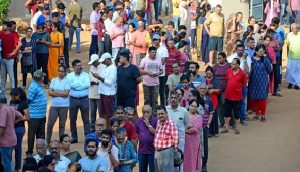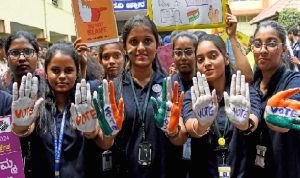28-04-2024
Bureau Report + Agencies
NEW DELHI: The second round of voting in India’s election is due to have closed, and attention now turns to the third round scheduled for May 7.
There will be seven phases in all.
Friday’s vote covered 166 million voters in 88 constituencies across 13 states and territories, from Kerala in the south to Jammu and Kashmir on the Himalayan frontier with Pakistan.
 Almost 1 billion people in the world’s most populous nation are eligible to vote, with results set for June 4.
Almost 1 billion people in the world’s most populous nation are eligible to vote, with results set for June 4.
Prime Minister Narendra Modi is expected to win a historic third term on the back of issues such as growth, welfare and hardline Hindu nationalism.
The Indian Election Commission has sought responses from Modi’s ruling Bharatiya Janata Party (BJP) and the opposition Congress on alleged violations of poll rules by Modi and Gandhi.
An hour before polls were due to close on day one of the Indian election, the average nationwide turnout stood at nearly 60%, according to the Election Commission of India.
Friday is the second of seven phases of voting. Votes will be counted on June 4.
Here is a breakdown of turnout as at 5 p.m. (1130 GMT);
Tripura- 77.53%, Manipur-76.06%, Chhattisgarh- 72.13%, West Bengal- 71.84%, Assam- 70.66%, Jammu and Kashmir- 67.22%, Kerala- 63.97%, Karnataka- 63.90%, Rajasthan- 59.19%, Madhya Pradesh-54.83%, Maharashtra- 53.51%, Bihar -53.03%, Uttar Pradesh- 52.74%
Prime Minister Narendra Modi has a mixed record of managing the economy, Nikunj Ohri and Manoj Kumar write.
 The Indian economy is projected to grow around 7% in the next financial year that starts from April 1, and there is “considerable scope” for India to grow above 7% by 2030, according to government estimates.
The Indian economy is projected to grow around 7% in the next financial year that starts from April 1, and there is “considerable scope” for India to grow above 7% by 2030, according to government estimates.
Modi’s government has subsidized construction of concrete houses for around 40 million impoverished households in a decade, and raised spending to build rural roads.
After low retail inflation during Modi’s first term, the economy has seen rises in retail prices, driven by post-pandemic global supply disruptions, higher import tariffs and an increase in global commodity prices.
The cost of living for the poor has risen sharply in the last five years due to a surge in food prices. Retail inflation in 2022/23 accelerated to 6.7% from 5.5% in 2021/22, and 6.2% the year ago.
The unemployment rate rose to 5.4% in 2022/23, from 4.9% in 2013/14, according to government estimates.
Nearly 16% of urban youth in the 15-29 years age group were unemployed in 2022/23, due to poor skills and lack of quality jobs, government data showed.
Estimates by private agencies are much higher.
The government met its privatisation target only twice in the last decade, with the notable sale of Air India, while it deferred stake sales in state-run banks and companies.
In 2023/24, the government may not be able raise even 300 billion rupees ($3.6 billion) through stake sales, less than 40% of budget target.
Modi’s critics said his government has not fulfilled the poll promise of doubling farmers’ income by 2022.
However, the government says steps like cash payouts to farmers, and raising crop procurement prices, among others, has helped in augmenting farmers’ income.
 Pressmediaofindia
Pressmediaofindia




